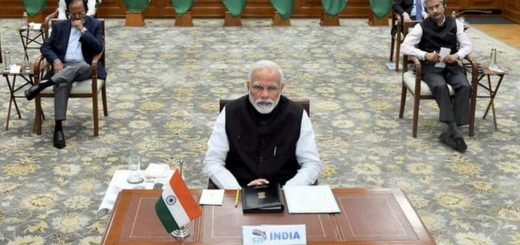Tech Multilateralism: Truth & Dream!

India is yet to develop its own framework of tech multilateralism in which the focus will remain on regional powers more rather than targeting the bulls of the game. A robust multilateral policy to secure national technological interests is awaiting.
Before starting any project, long deliberations are indispensable – these are the words of the great philosopher and creator of Niti Shastra; Chanakya (Sutra 22, Chanakya Niti). The said statement fits in all corners of the policymaking units involved in the expansion of multilateralism globally. With the advent of Artificial Intelligence (AI) in the 21st century, technology becomes integral to the most important factor of multilateral cooperation i.e. trade. It resulted in the domination by its developers (Western leaders) creating a big lacuna for the late catchers majorly Global South. Some catching-up economies cope with it by developing their communication frameworks and liberalising markets for technological cooperation.
After the first decade of 21st century amid rapid growth in the multilateralism of global order, the technology sector feels itself marginalised in this process. In the intergovernmental dialogues technological cooperation in defence, supply lines, and communication always finds its place but it is vehemently defeated as a core component in its diversification. Institutionalism setting of technology in the diplomatic arena currently rests in the backseat as its diversified results took other names in bilateral as well as multilateral cooperation. The governments of leading tech economies itself tighten technology liberalisation to gain profits majorly in regional affairs. Diversification of technologies posed in calculative dangers to the classical economic perspective and acted as a barrier to the universalisation of some basic human-centric techs. It led to technology wars, especially in the areas of the Global South.
The Truth
Technology wars become new trade wars. In year-on-year analysis, it is evident that digital trade was restricted by countries itself to take boon of emerging technologies in trade practices. If we notice the graph below, there is slide growth in technology loosening due to the COVID vaccine technology sharing and related equipment etc. The other analysis of this graph will indicate you about the tightening of technology trade immediately in the next year with a greater magnitude due to the rise in settling standards of the tech trade.

Multilateralism in the technology sector received the biggest setback under an umbrella term – security threat. The multilateral world order till the end of the 2000s decade treated security threats and economic offences separately but with the new interventions of digital techs in the commercial sector collided these two in a certain range of commonalities. These interconnections raise flags in banking, commerce and trading platforms heavily, resulting in an amalgamation of vigilance and scrutiny thoroughly at both ends of participation. The trend in the rise of digital trade walls from 2019 onwards shows how the countries are barricading their tech sector through paywalls and other means to curtail access to the new technological expeditions. The tightening – high-end software, knowledge sharing entities and loosening – banking, and data sharing of digital technologies shown majorly in the new decade.
The Case of India
India witnessed this multilateralism under some other words in 1947-1961 as universalism, the 1950s-1960s as Non-Alignment Movement (NAM), and in post-1991 onwards as LPG (Liberalisation, Privatisation & Globalisation) reforms. The fourth phase started in the COVID era, multilateralism finds its way again in the Indian context as the broken supply chains need diversification of imports and resources. Embracing all sort of organisations from G20 to BRICS to SCO to QUAD etc. make a start of the multi-alignment in regional cum global levels prominently. With the advent of the 21st century, the infusion of technological deliberations in bilateral, multilateral and Track-2 platforms took centre stage. But the multilateral order has been shaped by western majors and the say of India deterred for approximately two decades. In COVID and post-COVID times, the world acknowledged the technological potential cum presence of India from informal to formal stages. It itself opened avenues of benefits of multilateral arrangements towards Indian manufacturers and service providers. In NASSCOM analysis, it is found that from COVID times onwards Indian tech industries seen more access to funds for new start-ups and large technology firms expanded their presence overseas in crisis phase. The resilience generated to cope up with fall in local tech demands fulfilled through the tenets of regional multilateralism.
The very basic treatment in the technological sector is the ‘tightening’ of new-gen techs as we see in the above graph. The by-product of multilateralism; is regional multilateralism backed Indian stance in South and South East Asia majorly in terms of technological cooperation. The green flag from leaders from West made it more credible and investable for the regional economies to trust on the deeds of India. The regional competitors in tech production in Asia like Taiwan, China, South Korea and Japan has seen a tendency of the shift of major tech outlays towards India due to multiple resource-based reasons. But the dangers of tech multilateralism are more comparable to the G2G bilateral. For India, currently, it is an adaptive & workable technique is to rely more on the bilateral treatment of technology trade and adaption in co-development.

The Dream Ahead
The canorous point we hear is that digitalisation and enhanced connectivity have speed up the diffusion of technologies and related knowledge through varied modes. The availability of content is universally backed by several institutions who need to enhance multilateralism in technologies. This arena is highly contested by the cutting-edge tech tools used by alpha tech companies. However, the race for leading technologies is obvious and the only way to sustain in this race is to pace ourselves at sustenance levels. India currently needs more frequent and advanced access to the next-gen future technologies like IoT, Blockchain & Artificial Intelligence to imbibe them in day-to-day deliverables. Society 5.0 is a reality which uses robotics and resolves much in services as well as industries and agriculture. The prudence to yield results pass through multilateralism only. Those countries that posses R&D clusters can clinch the best of the future.
For the necessary arrangements, some key prioritise efforts may consider on desk –
- Building a big pool of digital talent for the acquisition of new technological tools and models working globally at par with their standards.
- Induction of a hybrid working model to rope in new tactics of breaking stereotypes i.e. a multilateral model of tech governance.
- Creation of new local markets which link existing hubs to the advanced international tech disbursal destinations.
- Turn international acing techs as a solution provider for local problems under the principle of ‘Alliance of Multilateralism’.
Conclusion
Indian experience of multilateralism in last 75 years taught us to develop own form of it in own neighbourhood. In technologies, the same connotation fits perfectly. In the highly competitive and capital-intensive Western and European R&D platforms, India can not achieve much for its own benefit. The ‘Atmanirbharta – Self Reliance’ is the key for India to establish itself as a regional leader first by innovative approach in technological landscapes. Indian technological frameworks and Science, Technology & Innovation policies are equipped with a forward-looking approach which needs to be brought down urgently. Multilateralism in technologies sounds sweet but the lack of adaptivity and reservations by countries made it difficult to absorb readily. Security observations and fear of monopoly over the tech-intensive platforms staggered states to open up frequently. Also, on the sidelines of offering advanced technologies, the tech-developing countries tested their advances as test cases. It materialises robust quality checks for them but alternatively shows power asymmetry in equal status quo. It backfired in many cases among states where unequal treatment failed mega tech deals. Hence, the truth is that the dream of Tech Multilateralism can be acquired ideologically but treat it with caution strategically.



















